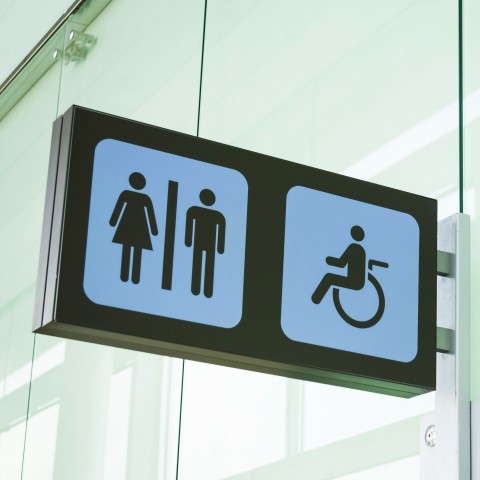
When you learn any language, knowing its basic sentence patterns helps you get a grip of the language as a whole, and allows you to communicate more effectively. So if you’re a Thai learner and don’t know how to form sentences in Thai yet, knowing certain Thai sentence structures and patterns is like a shortcut to creating your own sentences.
In this lesson, we’ll teach you common Thai sentence patterns that you can use in daily life. While there are various types of sentence patterns in the Thai language, we’ll focus on just ten patterns with examples. Also keep in mind that we won’t be focusing on the tenses today.
Let’s get started!
 Table of Contents
Table of Contents
- Linking Two Nouns: A is B
- Describing Nouns: A is [Adjective]
- [Subject] Wants / Needs
- [Subject] has to [Verb]
- [Subject] Likes [Noun/Verb]
- Please…
- May I? / Can I?
- What is…?
- When is…?
- Where is…?
- Conclusion
1. Linking Two Nouns: A is B
Before we give you our list of Thai sentence patterns, we think you should know some basic vocabulary:
- รูปแบบประโยค (rûup-bàaep-bprà-yòok) is “sentence pattern”
- รูปแบบ (rûup-bàaep) is “pattern”
- ประโยค (bprà-yòok) is “sentence”

The first simple Thai sentence pattern you should know is “A is B,” which is used for linking two nouns. Below are some examples of this Thai sentence structure.
Sentence structure:
A + เป็น (bpen) + B
A + คือ (khuue) + B
Explanation:
เป็น (bpen), อยู่ (yùu), and คือ (khuue) are used for the verb “to be” in Thai. While they all refer to the same verb, เป็น (bpen), อยู่ (yùu), and คือ (khuue) have different meanings, are used in different situations, and can’t substitute one another.
- เป็น (bpen) is used to explain what A is. The information used to explain A can include things such as a person’s job or marital status.
- อยู่ (yùu) is used to explain where A is. So in this case, B is the place.
- คือ (khuue) is used to explain what A is. The information used to explain A is either a fact/status that doesn’t change, or information that other parties don’t know.
Because เป็น (bpen) and คือ (khuue) seem pretty similar, it can be difficult to decide which one to use in a given scenario. Even Thai people find this hard; they can use it correctly, but can’t explain why. Let’s look at some Thai example sentences to help you understand better.
Example 1:
แม่เป็นครู
mâae-bpen-khruu
“Mom is a teacher.”

Mom is a teacher.
Example 2:
แก้วเป็นสาวโสด
gâaew-bpen-sǎao-sòot
“Kaew is a single lady.”
Example 3:
ฤทธิเป็นคนที่ไม่เก่งเลขเลย
rít-bpen-khon-thîi-mâi-gèng-lêek-looei
“Rit is a person who is not good at math.”
Example 4:
ตอนนี้รัตน์อยู่ที่นี่
dtaawn-níi-rát-yùu-thîi-nîi
“Rat is here now.”
Example 5:
กระเป๋าอยู่บนโต๊ะทานอาหาร
grà-bpǎo-yùu-bon-dtó-thaan-aa-hǎan
“The bag is on the dining table.”
Example 6:
หมีแพนด้าอยู่ในสวนสัตว์ที่เชียงใหม่
mǐi-phaaen-dâa-yùu-nai-sǔuan-sàt-thîi-chiiang-mài
“Pandas are in the zoo at Chaingmai.”
Example 7:
ที่นี่คือโรงพยาบาลที่ใหญ่ที่สุดในจังหวัด
thîi-nîi-khuue-roong-phá-yaa-baan-thîi-yài-thîi-sùt-nai-jang-wàt
“Here is the largest hospital in the province.”

Here is the largest hospital in the province.
Example 8:
ลัดดาคือเพื่อนที่ดีที่สุดของฉัน
lát-daa-khuue-phûuean-thîi-dii-thîi-sùt-khǎawng-chǎn
“Ladda is my best friend.”
Example 9:
ผลไม้ที่พ่อชอบกินที่สุดคือแตงโม
phǒn-lá-mái-thîi-phâaw-châawp-gin-thîi-sùt-khuue-dtaaeng-moo
“Dad’s favorite fruit is watermelon.”
2. Describing Nouns: A is [Adjective]
Another Thai sentence construction you should know is “A is [Adjective].” This is a very easy Thai sentence pattern, used to describe nouns with adjectives. Let’s take a look.
Sentence structure:
Noun + Adjective
Explanation:
If you want to describe a noun, all you have to do is put the adjective after that noun.
Example 1:
กานดาสูงและผอม
gaan-daa-sǔung-láe-phǎawm
“Ganda is tall and slim.”
Example 2:
เก้าอี้ไม้ตัวนั้นราคาแพงมาก
gâo-îi-mái-dtuua-nán-raa-khaa-phaaeng-mâak
“That wooden chair is very expensive.”
Example 3:
มะระสีเขียวและมีรสขม
má-rá-mii-sǐi-khǐiao-láe-mii-rót-khǒm
“Bitter melon is green and bitter.”
Additional note:
มะระ (má-rá) is “bitter melon” in Thai. It’s one of the fruits that Thai people like to eat.

3. [Subject] Wants / Needs
Some of the most useful Thai phrases are those for expressing “want” and “need.” There are a few different Thai sentence patterns you should remember for this.
Sentence structure:
subject + ต้องการ (dtâawng-gaan) + noun / verb
subject + อยาก (yàak) + verb
subject + อยากได้ (yàak-dâi) + noun
Explanation:
ต้องการ (dtâawng-gaan), อยาก (yàak), and อยากได้ (yàak-dâi) mean both “want” and “need” in Thai, and can substitute one another.
However, ต้องการ (dtâawng-gaan) sounds more formal than อยาก (yàak) and อยากได้ (yàak-dâi). Thai people often use ต้องการ (dtâawng-gaan) in formal situations, and อยาก (yàak) and อยากได้ (yàak-dâi) in casual conversations.
To express your wants and needs, you can use any of the structures above. Here are a few Thai sentence examples for you.
Example 1:
คุณครูต้องการคอมพิวเตอร์เครื่องใหม่
khun-khruu-dtâawng-gaan-khaawm-phíu-dtôoe-khrûueng-mài
“The teachers want a new computer.”
Example 2:
โรงพยาบาลต้องการจ้างนางพยาบาลเพิ่ม
roong-phá-yaa-baan-dtâawng-gaan-jâang-naang-phá-yaa-baan-phôoem
“The hospital wants to hire more nurses.”
Example 3:
เธอต้องการอะไรเพิ่มมั๊ย
thooe-dtâawng-gaan-à-rai-phôoem-mái
“Do you want anything more?”
Example 4:
น้ำตาลอยากไปเที่ยวหัวหิน
nám-dtaan-yàak-bpai-thîiao-hǔua-hǐn
“Namtan wants to go to Huahin.”
Example 5:
แม่อยากลองทำเค้กสูตรใหม่
mâae-yàak-laawng-tham-khéek-sùut-mài
“Mom wants to try a new cake recipe.”

Mom wants to try a new cake recipe.
Example 6:
มินท์อยากแต่งงานก่อนอายุ 30 ปี
mín-yàak-dtàaeng-ngaan-gàawn-aa-yú-sǎam-sìp
“Mint wants to get married before she is 30 years old.”
Example 7:
ฉันอยากได้รองเท้าคู่ใหม่
chǎn-yàak-dâi-raawng-tháo-khûu-mài
“I want a new pair of shoes.”
Example 8:
รพีไม่อยากได้งานเพิ่ม
rá-phii-mâi-yàak-dâi-ngaan-phôoem
“Rapee doesn’t want more jobs.”
Example 9:
มีใครอยากได้ชาเพิ่มมั๊ย
mii-khrai-yàak-dâi-chaa-phôoem-mái
“Anyone want more tea?”
4. [Subject] has to [Verb]
Another basic Thai sentence pattern you should know is “I have …”. You can use this Thai sentence pattern to express what you have to do.
Sentence structure:
Subject + ต้อง (dtâawng) + Verb
Explanation:
This type of sentence in Thai is pretty easy and straightforward. You just put the subject, followed by ต้อง (dtâawng), which means “must” or “have to” in Thai, and then the verb.
Example 1:
เธอต้องออกจากบ้านเดี๋ยวนี้ ไม่งั้นจะสาย
thooe-dtâawng-àawk-jàak-bâan-dǐiao-níi mâi-ngán-jà-sǎai
“You have to leave now or else you will be late.”
Example 2:
ยายต้องกินยาก่อนนอนทุกวัน
yaai-dtâawng-gin-yaa-gàawn-naawn-thúuk-wan
“Grandma has to take medicine before bed every day.”
Example 3:
วรรณาต้องไปเชียงรายพรุ่งนี้
wan-naa-dtâawng-bpai-chiiang-raai-phrûng-níi
“Wanna has to go to Chiangrai tomorrow.”
5. [Subject] Likes [Noun/Verb]
Another common Thai language sentence structure is that for expressing likes and preferences. It’s one of the most basic Thai sentence patterns you can use to talk about your favorite things and activities.
Sentence structure:
Subject + ชอบ (châawp) + Noun / Verb
Explanation:
ชอบ (châawp) is “like” in Thai. To use this sentence pattern, you put the subject, followed by ชอบ (châawp), and then the noun or verb.
Example 1:
แม่ชอบกินแก้วมังกร
mâae-châawp-gin-gâaeo-mang-gaawn
“Mom likes to eat dragon fruits.”
Example 2:
นภาชอบสีชมพู
ná-phaa-châawp-sǐi-chom-phuu
“Napa likes pink.”

Napa likes pink.
Example 3:
ตุ้มไม่ชอบดูหนังผี
dtûm-mâi-châawp-duu-nǎng-phǐi
“Tum doesn’t like scary movies.”
6. Please…
The next basic Thai sentence structure we’ll show you is used to politely ask someone to do something. There are two Thai sentence patterns you need to know.
Sentence structure:
กรุณา (gà-rú-naa) + Verb
ช่วย (chûuai) + Verb
Explanation:
Thai people use กรุณา (gà-rú-naa) and ช่วย (chûuai) when they want to ask others to do something. กรุณา (gà-rú-naa) and ช่วย (chûuai) are pretty much the same, except กรุณา (gà-rú-naa) is used in formal situations while ช่วย (chûuai) is more often used in casual conversations.
Example 1:
กรุณาถอดรองเท้าก่อนเข้าห้อง
gà-rú-naa-thàawt-raawng-tháo-gàawn-khâo-hâawng
“Please take off your shoes before entering the room.”
Example 2:
กรุณาอย่าส่งเสียงดัง
gà-rú-naa-yàa-sòng-sǐiang-dang
“Please don’t make loud noises.”
Example 3:
กรุณาให้ความร่วมมือกับเจ้าหน้าที่
gà-rú-naa-hâi-khwaam-rûuam-muue-gàp-jâo-nâa-thîi
“Please cooperate with our staff.”
Example 4:
ช่วยฉันทำความสะอาดห้องหน่อย
chûuai-chǎn-tham-khaawm-sà-àat-hâawng-nàauy
“Please help me clean the room.”
Example 5:
ช่วยเงียบหน่อย
chûuai-ngîiap-nàauy
“Please be quiet.”

Please be quiet.
Example 6:
ช่วยเดินเร็ว ๆ หน่อย
chûuai-dooen-reo-reo-nòi
“Please walk faster.”
7. May I? / Can I?
This sentence pattern in Thai is used to ask for permission. However, this is considered an imperfect sentence because Thai people leave the word “may” or “can” out.
Sentence structure:
ขอ (khǎaw) + Verb + ได้มั้ย (dâi-mái)
Explanation:
This Thai sentence pattern is quite different from its English counterpart. This is because there is no ฉัน (chǎn), which is “I” in Thai, in the sentence.
You start the sentence with ขอ (khǎaw), which means “ask.” Next, you put the verb, followed by ได้มั้ย (dâi-mái), which is used to make a permission question in Thai.
Example 1:
ขอเข้าไปได้มั้ย
khǎaw-khâo-bpai-dâi-mái
“May I come in?”
Example 2:
ขอยืมหนังสือเล่มนั้นได้มั้ย
khǎaw-yuuem-nǎng-sǔue-lêm-nán-dâi-mái
“Can I borrow that book?”

Can I borrow that book?
Example 3:
ขอไปดูหนังกับเพื่อนวันเสาร์นี้ได้มั้ย
khǎaw-bpai-duu-nǎng-gàp-phûuen-wan-sǎo-níi-dâi-mái
“Can I go see the movie with my friend this Saturday?”
8. What is…?
Another useful Thai sentence pattern you should learn is “What is…?” You can use this sentence pattern in Thai to ask for information about something.
Sentence structure:
… + คือ (khuue) + อะไร (à-rai)
Explanation:
As mentioned earlier, คือ (khuue) is one of the words for the verb “to be” in Thai. Also note that อะไร (à-rai) is “what.”
You may notice that Thai people use คือ (khuue), not เป็น (bpen), in this sentence structure. This is because you’re asking for information you don’t know.
Example 1:
นี่คืออะไร
nîi-khuue-à-rai
“What is this?”
Example 2:
อาหารที่เราสั่งครั้งที่แล้วคืออะไร
aa-hǎan-thîi-rao-sàng-khráng-thîi-láaeo-khuue-à-rai
“What is the food we ordered last time?”
Example 3:
เครื่องดื่มที่คุณชอบคืออะไร
khrûueng-dùuem-thîi-khun-châawp-khuue-à-rai
“What is your favorite drink?”
9. When is…?
Now that you’ve learned the “What is …?” sentence structure, it makes sense to learn the “When is…?” structure as well. With this structure, you can make Thai phrases for asking about the time.
Sentence structure:
… + เมื่อไหร่ (mûuea-rài)
Explanation:
เมื่อไหร่ (mûuea-rài) is “when” in Thai. You put the event that you want to know the time of, followed by เมื่อไหร่ (mûue-rài).
Example 1:
ประชุมเมื่อไหร่
bprà-chum-mûuea-rài
“When is the meeting?”
Example 2:
เธอจะเริ่มทำงานเมื่อไหร่
thooe-jà-rôoem-tham-ngan-mûuea-rài
“When will you start working?”
Example 3:
ตาลจะมาถึงเมื่อไหร่
dtaan-jà-ma-thǔeng-mûuea-rài
“When will Tarn arrive?”
10. Where is…?
You can now ask for more information and about the time. In this section, we’ll also teach you how to ask about location. This is one of those basic Thai phrases you’ll use all the time!
Sentence structure:
Place + อยู่ที่ไหน (yùu-thîi-nǎi)
Place + ไปทางไหน (bpai-thaang-nǎi)
Explanation:
Both of the structures above are pretty similar to each other, and are used to ask about location. The first one is the Thai translation sentence pattern of “Where is …?” The other is closer to: “How to go to …?”
Example 1:
ห้องน้ำอยู่ที่ไหน
hâawng-nám-yùu-thîi-nǎi
“Where is the toilet?”

Where is the toilet?
Example 2:
บ้านของเธออยู่ที่ไหน
bâan-khǎawng-thooe-yùu-thîi-nǎi
“Where is your house?”
Example 3:
ภูเขาที่สูงที่สุดในไทยอยู่ที่ไหน
phuu-khǎo-thîi-sǔung-thîi-sùt-nai-thai-yùu-thîi-nǎi
“Where is the highest mountain in Thailand?”
Example 4:
จุดชมวิวไปทางไหน
jùt-chom-wiu-bpai-thaang-nǎi
“How to go to the viewpoint?”
Example 5:
สถานีตำรวจที่ใกล้ที่สุดไปทางไหน
sà-thǎa-nii-dtam-rùuat-thîi-glâi-thîi-sùt-bpai-thaang-nǎi
“How to go to the nearest police station?”
Example 6:
ประชาสัมพันธ์ไปทางไหน
bprà-chaa-sǎm-phan-bpai-thaang-nǎi
“How to go to the information center?”
11. Conclusion
The lesson has finally come to an end, and you’ve already learned ten useful Thai sentence patterns for everyday use! We hope they’re not too hard for you, but remember that it may take a while to memorize all of them. Using a variety of Thai sentence patterns in daily conversations will help you get familiar with them; eventually, you’ll be able to use them with great fluency.
Are there any specific topics you want to learn about in future articles? Leave us a comment to let us know! If you have no clue what you want to learn next, we have a list of fun lessons for you at ThaiPod101.com, so don’t forget to check it out.
If you want to know more about sentence structure in Thai, our word order article is a great place to expand your knowledge. However, if that’s too serious a lesson for you, what about listening to a conversation about Thai tea and a date? Our lesson about ordering food at restaurants is also an interesting choice.
Happy learning!










